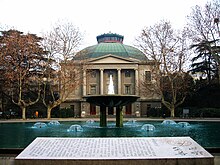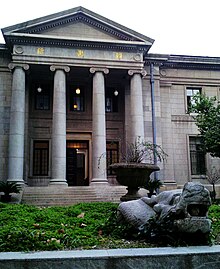University of Southeast China
| 东南 大学 University of Southeast China |
|
|---|---|

|
|
| motto | 止于至善 striving for perfection |
| founding | 1902 |
| Sponsorship | state |
| place | Nanjing , China |
| president | Zhang Guangjun |
| Students | 16,125 (undergraduates) / 16,749 (postgraduates) |
| Employee | 5,030 (2017) |
| Annual budget | € 827.1 million (2017) including € 72.6 million third-party funding |
| Website | www.seu.edu.cn |
The University of Southeast China ( Chinese 東南 大學 / 东南 大学 , Pinyin Dōngnán Dàxué , English Southeast University , short 东 大 , Dōngdà , English SEU ) in Nanjing ( People's Republic of China ).
It is one of the most important national universities and one of the oldest educational institutions in China, directly administered by the Ministry of Education of China.
history
Its origins go back to 258 . In 1902 it was converted into a modern college and founded as the "Sanjiang Pedagogical College" (三江 师范 学堂).
In the following 50 years it changed name several times. It was called u. a. 1905–1911 "Liangjiang Pedagogical College" (两 江 师范 学堂), 1914–1925 "Nanjing Higher Pedagogical School" (南京 高等 师范学校), 1926 "Southeast China State University" (国立 东南 大学), 1927–1930 "State Fourth Sun Yatsen University "(国立 第四 中山大学) and" Jiangsu State University "(国立 江苏 大学), 1930–1949" Central State University "(国立 中央 大学) and 1949–1952" Nanjing State University "(国立 南京大学). During the nationwide reorganization of universities and colleges in 1952, it was converted into "Nanjing Technical University" (南京 工学院).
In May 1988 the university got its current name. In April 2000, the Nanjing Medical Railway University (南京 铁道 医学院), the Nanjing Jiaotong University of Applied Sciences (南京 交通 高等 专科学校) and the Nanjing Geological School (南京 地质 学校) were merged with the University of Southeast China . The main campus is located in the center of Nanjing's old town.
The university is considered the birthplace of modern science in the People's Republic of China; In many cases it has played a pioneering role in the Chinese education system, for example with the introduction of co-education and student-centered teaching methods in contrast to traditional frontal teaching. Former President Jiang Zemin is one of the most prominent graduates .
The University of Southeast China is one of the leading research universities in China and has always been among the top 10 in scientific research and development in numerous rankings.
Organization and direction
structure
The University of Southeast China is a comprehensive university with the departments of technology, arts, social sciences, law, economics, management and languages. The focus is on engineering. The university has more than 34 schools or departments with a total of 76 undergraduate disciplines. It has 30 post-doc positions and offers 95 PhD programs and 208 Master’s programs. Further areas are architecture, construction, electronics, information technology, energy, power engineering and traffic engineering.
The total number of faculty and staff is 5,030, including 2,832 full members or associate professors, 450 doctoral students, regulatory agencies, 12 academics from the Chinese Academy of Sciences and Engineering, 48 "Cheung Kong Scholar" professors. There are currently over 31,000 full-time students, approximately 10,000 of whom are PhD students. It has more than 50 national and provincial research institutes. The research fund exceeded RMB 2.31 billion in 2017.
In addition to the Sipailou Campus and Dingjiaqiao Campus in the city center, there has been another Jiulonghu Campus, also named after its district, since 2006. Younger students in particular are accommodated there. The total area is 427 hectares.
Faculties
The University of Southeast China has the following faculties:
- Mechanical engineering and power engineering
- Materials science and chemical engineering ( chemical engineering )
- Electrical engineering
- Information technology
- Public administration
- Computer science
- architecture
- Biomedicine and device technology
- management
- Chien-Shiung Wu Honors College
- foreign languages
- Social science
- Economics
- law
- medicine
Library
With an area of 66,900 m² (January 2017) and over 4.24 million volumes (December 2017), the university library is one of the 10 largest in China.
- Sipailou : Branch library for natural sciences, techniques and literature
- Dingjiaqiao : Life Sciences and Medicine Branch Library
- Liwenzheng : Main library for most students
International contacts
International cooperation and exchange play an important role in the development of Southeast University. Since 1978, more than 4,000 teachers or researchers have been sent abroad for academic activities or exchanges, and more than 3,500 foreign experts and teachers have been invited to the university for lectures, collaborative research or academic exchange. More than eleven thousand international students from 100 countries have studied at the university and over 9,000 of them have completed their studies there.
The university pursues the development of international cooperation programs with other countries. So far, there have been friendly cooperation agreements with more than 150 universities, research institutes or companies in countries such as Australia, Great Britain, Canada, France, Germany, Italy, Japan, Korea, Singapore, Switzerland, Sweden, USA, etc.
Rankings
In 2017, the China Academy for Management awarded the following ranks:
- No. 16 (General Ranking)
- No. 5 in engineering
- No. 18 in the field of science
- No. 23 in the field of humanities and social sciences




